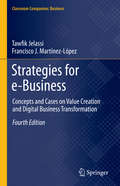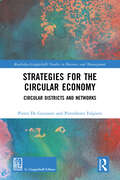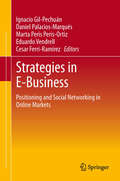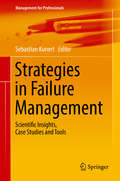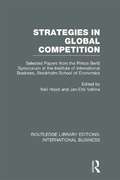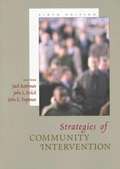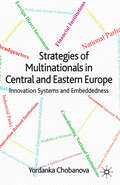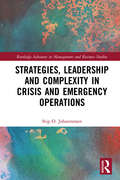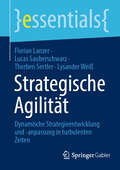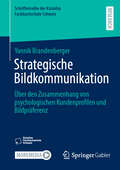- Table View
- List View
Strategies for e-Business: Concepts and Cases on Value Creation and Digital Business Transformation (Classroom Companion: Business)
by Francisco J. Martínez-López Tawfik JelassiThis is the fourth edition of a unique textbook that provides extensive coverage of the evolution, the current state, and the practice of e-business strategies. It provides a solid introduction to understanding e-business and e-commerce by combining fundamental concepts and application models with practice-based case studies. An ideal classroom companion for business schools, the authors use their extensive knowledge to show how corporate strategy can imbibe and thrive by adopting vibrant e-business frameworks with proper tools. Students will gain a thorough knowledge of developing electronic and mobile commerce strategies and the methods to deal with these issues and challenges.
Strategies for the Circular Economy: Circular Districts and Networks (Routledge-Giappichelli Studies in Business and Management)
by Pietro De Giovanni Pierroberto FolgieroThis book illustrates two approaches for firms to shape successful circular strategies, namely, the Circular Economy and Circular Districts. The former considers firms’ challenges when turning theoretical circular models into practice. Thus, it discusses the opportunities and difficulties in reshaping corporate strategies by reflecting on circular economy principles. The latter approach plays a new role within the new economy systems and this book conceptualizes and operationalizes its definition. The circular district can represent an effective way to accelerate the energy transition process by developing industrial collaborations and exploiting technology synergies to enhance circularity and achieve economic, environmental, and social targets. The book highlights how firms should adjust their strategic thinking, redesign their network of relationships, and reconsider the value creation process when the circular economy is a concrete option. Furthermore, it examines the evolution from circular economy to circular districts by revealing the motivations that push firms and supply chains to redesign their strategies by considering the perspective of a circular district. The book ends by analyzing business experiences in these two areas and proposes advancements for both the scientific community and the business world. The book offers a blend of theoretical frameworks and practical applications and will be of particular interest to scholars in the fields of sustainable operations, closed-loop supply chain, green supply chain management, and circular supply chains. Also, the operationalization of the concept of circular districts, offers a genuine and original theoretical contribution, thus targeting students from Executive programs, MBA programs, and PhD programs. The book will also attract managers, practitioners and professionals interested in real-world cases and experiences as well as practical developments in the domain.
Strategies in E-Business
by Ignacio Gil-Pechuán Daniel Palacios-Marqués Marta Peris Peris-Ortiz Eduardo Vendrell Cesar Ferri-RamirezIn this volume, the authors apply insights from a variety of perspectives to explore the alignment among strategy, organization design, process and human resource management, and e-business practices on developing successful social networking programs--with particular regard to applying such initiatives against the backdrop of the global financial crisis and challenges to traditional business models. Showcasing in-depth case studies, the authors present emerging approaches to analyze the impact of investment in social networking sites, aligning internal resources, and measuring effects on positioning, branding, and new business creation. The fact that a growing proportion of the world population has a relationship with social networking sites could prove very valuable for companies. The question is whether this represents a business opportunity, whether companies know how to make the most of it and if they will make the necessary efforts to adapt to these new platforms. In the modern world, social networking sites have enormous potential for large as well as small and medium-sized enterprises (SMEs); most companies are aware of the need for a presence on social networking sites, but at present their e-business strategies are part of their medium and long-term strategic planning and only a small percentage have been put into practice. In short, this book attempts to answer the following questions: Is there a business opportunity for companies on social networking sites? Do they know how to make the most of it? Are they willing to make the necessary effort to adapt? Can e-business strategies contribute to company creation and the success of already existing businesses? And if so, how?
Strategies in Failure Management: Scientific Insights, Case Studies and Tools (Management for Professionals)
by Sebastian KunertThis book offers a comprehensive overview of failure in business, management and consulting. It features contributions by experts from diverse fields, who share unique insights from their real-life experiences. Readers will find perspectives from leadership, project management, change management, innovation management, human resource management, counseling, restructuring, entrepreneurship and sports. Each chapter combines the latest empirical findings with relevant case studies, making for a unique book that offers a fascinating exploration of the largely unexplored area of setbacks, pitfalls, flops and disappointments in the business world.
Strategies in Global Competition: Selected Papers from the Prince Bertil Symposium at the Institute of International Business (Routledge Library Editions: International Business)
by Neil Hood Jan-Erik VahlneThe main thrust of Part 1 is to give some understanding of the concept of ‘global competition’. In doing so, the chapters rely heavily on industrial studies. Part 2 deals with two different aspects of this change viewed from two different perspectives. The one is economic and more macro: the other political and social and more micro, being concerned with the way in which companies have to utilize their various organisational units and integrate information on a fragmented environment into a strategic whole. Part 3 deals specifically with technology, as the particular segment of the environment which often has the largest impact on future strategies. In Part 4 the perspective of global competition is applied at industry, country and company levels and it is shown that this perspective adds new dimensions to old problems. The final parts address the problem of management in global competition.
Strategies in Sustainable Tourism, Economic Growth and Clean Energy
by Muhammad Shahbaz Daniel Balsalobre-Lorente Oana M. DrihaThis book provides an in-depth analysis of and discussion about the relationship between green tourism, economic growth and globalization. It explores numerous topics relating to tourism including transport efficiency, foreign direct investment, clean energy, climate change dynamics and advances in sustainable tourism management. The book begins with discussion of sustainable tourism and economic growth, particularly focusing on management strategies. It then presents the relationship between energy use and tourism, looking at green energy and energy shock. It then discusses transport efficiency, tourism efficiency and financial growth in both developed and developing countries. This book is of interest to researchers, policymakers, and postgraduate students in the areas of energy, environmental and tourism economics.
Strategies of Community Intervention (6th edition)
by Jack Rothman John L. Erlich John E. TropmanThis volume takes a broad view of community organization, viewing it as a rich and diverse field of practice that includes policy analysis and development, program planning, administration, evaluation, and resource development and allocation. The Sixth Edition emphasizes strategic and tactical considerations in community change. It treats social planning and policy initiatives, neighborhood-based citizen and empowerment approaches, and advocacy-oriented social action.
Strategies of Financial Regulation: Divergent Approaches in Conduct of Business Regulation of Mis-Selling in the UK and South Korea
by Junghoon KimThis book analyses different strategies and their results in implementing financial regulation in terms of rule-making, public enforcement and private enforcement. The analysis is based on a comparative study of conduct of business regulation on mis-selling of financial instruments in the UK and South Korea. It extends into liquidity regulation in the banking sector and credit rating agency regulation. The book concludes that in rule-making, purposive rules are more effective for achieving regulatory goals with minimal undesirable results, but a rule-making system with purposive rules can only work on a foundation of trust among rule-makers, enforcers and the regulates, that with respect to public enforcement, the enforcement strategies should combine the compliance-oriented and deterrence-oriented approaches and be continuously adjusted based on close monitoring of the regulatory outcomes and that in private enforcement, regulation should be instituted as the minimum requirement in private law.
Strategies of Micro-Enterprises in the Recording Industry: How Independent Jazz Labels Navigate the Music Landscape (Music Business Research)
by Michaela Drnek BókováThis book examines the creative and flexible approaches independent jazz labels use to navigate today’s challenging music industry landscape. By combining desk research with in-depth interviews with label owners and digital distributors, this study sheds light on how these micro-enterprises confront limited resources, the impact of streaming services, and an increasingly digital marketplace. It explores key strategies in financial management, distribution, and marketing, revealing how adaptability and creative problem-solving are essential to building a sustainable business. The findings emphasize the role of community building and digital marketing in reaching audiences, as well as the strategic use of digital tools for distribution. Through this detailed analysis, the study offers a practical understanding of the day-to-day realities and long-term goals of independent jazz labels, along with valuable insights for small music enterprises striving to stay relevant. The book is valuable for both an academic audience and practitioners in the field of music production.
Strategies of Multinational Corporations and Social Regulations
by Xavier Richet Violaine Delteil Patrick DieuaideThis contributed volume seeks to provide a unique window on the globalization process by analyzing the dynamics of Foreign Direct Investment (FDI) in Europe and Asia, as well as its influence on the renewal of public policies and regulations, both transnational and local. It discusses the link between the trans-nationalization of productive and business systems and the renewal of local regulations in the light of concerns over competitiveness and attractiveness, as well as new social tensions. Multinational corporations (MNCs) as key actors of globalization are central for understanding the new interactions between the global, regional and local dimensions as well as for highlighting the challenges of regulation both at transnational level and within national boundaries. Research approaches along two broad lines are presented: First, a theoretical and empirical approach that examines links between the strategies of multinationals and local public policy in order to contribute to a better understanding of the institutional dynamics of social regulation. Second, a comparative approach that compares regional spaces, with particular attention to Europe on the one hand, and to the two great emerging powers, China and India, on the other.
Strategies of Multinationals in Central and Eastern Europe
by Yordanka ChobanovaThe focus of the study is on the larger food processing companies, which invested in Central and Eastern Europe - namely Nestl#65533;, Unilever and InBev - and analyses the motives of investment and the entry strategies of food MNEs, outlines their contribution to the local development and stresses the national actors as forces to embedded FDI.
Strategies of Related Diversification
by Bharat N. AnandWhich businesses should a firm expand into? This question of corporate scope is central to corporate strategy. Flawed scope decisions can have severe consequences, and the trauma experienced by many companies as a result of mistaken decisions to expand scope is often large. What leads to such mistakes? Where do managers go wrong? And, what might be a sensible logic by which to approach the question of scope expansion? Examines these questions and the logic of the scope decision in those instances where the target business is ostensibly related in some way to a company's existing ones.
Strategies of Sustainable Development in China’s Wind Power Industry
by Jiachun Li Dexin HeThis book reviews the status quo and visions for the future in the wind energy industry in China and around the globe, focusing on its roles in optimizing energy structure, alleviating environmental pollution, and coping with climate change. Providing a blueprint of wind power development till 2050, it suggests a series of further measures in the context of policies, regulations, laws, and marketing in order to overcome the existing bottlenecks. Moreover, it proposes a number of potential innovative technologies related to IT+ and advanced manufacturing, including integrated & distributed power and micro-grid systems, multi-energy complement, green and intelligent manufacturing, reliability design, blade design, manufacturing and maintenance, drive drain systems, and offshore wind farms. This book offers researchers and engineers insights into sustainable development in the wind power industry.
Strategies of Unrelated Diversification
by Bharat N. Anand Samhita JayantiConglomerates lie at the heart of debates in corporate strategy. They include, perhaps, the best known companies in history--Beatrice Corp., General Electric, ITT, Siemens, and ABB--and at various times over the last few decades have been both admired and vilified as a form of corporate organization. Regardless of the time at which these debates have occurred, they invariably focus on a few common questions, which this note addresses: Why do conglomerates exist? Do they add value to their component businesses? If so, how?
Strategies to Achieve a Binding International Agreement on Regulating Cartels
by John Sanghyun LeeThis book addresses the lack of binding multi-lateral international agreement on cartels, through analysis of trials and failures. It also suggests strategic approaches to overcome current standstills. In addition, the book contrasts international agreement on cartels with inter-governmental commodity agreement which has been developed separately through international law. Through this project, the author puts forth that successful international law on cartels needs to reflect the interests and arguments of developing countries.
Strategies, Leadership and Complexity in Crisis and Emergency Operations (Routledge Advances in Management and Business Studies)
by Stig JohannessenStrategies, Leadership and Complexity in Crisis and Emergency Operations will bring together the main themes of strategy, operational leadership, organizational dynamics and complexity in the context of crisis and emergency operations; creating a book that is timely and relevant for research and leadership in emergency services, the police, military and other organizations involved in operations in highly dynamic and critical contexts. Based on two recent Scandinavian cases, Strategies, Leadership and Complexity in Crisis and Emergency Operations identifies theoretically generalizable dimensions in the discussion of emerging strategies and leadership in complex, uncertain and dynamic situations during crisis and emergency operations. The book will offer original material and discussions from these cases on how strategies, leadership and organizational dynamics evolve during crisis and emergency operations - and further link these to existing international cases and research In light of theories and fields of knowledge emphasising complex organizational dynamics, discussions are coupled with examples from different organizations and countries. The knowledge fields draw on a wide range of new organizational complexity research, and insights from more established work. The intention is to integrate established and recent organizational research in order to understand dynamic practices of organizations during crisis and emergency operations.
Strategiewerkzeuge aus der Praxis: Analyse und Beurteilung der strategischen Ausgangslage
by Traute KaufmannAus der Praxis - für die Praxis: Strategiewerkzeuge, welche Ihre Methodenkompetenz steigernFührungskräfte, Mitarbeitende, Studierende und Forschende, welche die strategische Ausgangslage eines Unternehmens systematisch, zielgerichtet und aus unterschiedlichen Perspektiven heraus analysieren wollen, finden in diesem Buch wirkungsvolle Werkzeuge. Lebensfähigkeitsanalyse, Wertkette, Sortimentsanalyse, Kundenportfolio oder Marktsegmentierung: Eingebunden sind die wichtigsten Erkenntnisse und Instrumente bekannter strategischer Vordenker, aber auch weniger verbreitete Werkzeuge, welche die Autorin in ihrer jahrzehntelangen beraterischen Praxis erfolgreich eingesetzt hat und die sich dort immer wieder als Best-Practice bewähren. Vertieftes Anwendungswissen und konkrete Anleitungen für den Umgang mit den besten Analyseinstrumenten zur Unternehmens- und Geschäftsfeldanalyse Im Vordergrund steht deren nutzenbringender Einsatz. Die systematische Anordnung der Instrumente entlang des Strategieerarbeitungsprozesses erlaubt dem Leser einen schnellen Überblick darüber, welches Werkzeug in welcher Phase des Prozesses geeignet ist. Die strukturierte, vertiefte Darstellung der einzelnen Instrumente ermöglicht eine sichere Beurteilung darüber, welches Tool für welche analytische Fragestellung Nutzen stiftet. Die Kapitel sind so angelegt, dass für jedes Instrument der Schritt vom Wissen über die Anwendung hin zum Nutzen durch Praxisbeispiele vollzogen werden kann. Darüber hinaus erhalten Sie online einen kostenlosen Zugriff auf Excel-basierte Tools (z. B. Erfahrungs- und Industriekostenkurve), die sofort für die eigene Analyse- und Strategiearbeit eingesetzt werden können.Der Inhalt UmfeldanalyseUnternehmensanalyseMarktsegmentierungGeschäftsfeldanalyseDieses Buch bietet Ihnen: wirksame Werkzeuge für die erfolgreiche StrategiearbeitSteigerung der eigenen Methodenkompetenz sowie der Effektivität und EffizienzKonzentration der Kräfte auf die richtigen und Best-Practice-WerkzeugeProfessionalisierung der StrategiearbeitSteigerung der Wirksamkeit von Unternehmens-, Segment- und Funktionalstrategien
Strategiewerkzeuge aus der Praxis: Band 1: Analyse und Beurteilung der strategischen Ausgangslage
by Traute KaufmannFührungskräfte, Mitarbeitende, Studierende und Forschende, welche die strategische Ausgangslage eines Unternehmens systematisch, zielgerichtet und aus unterschiedlichen Perspektiven heraus analysieren wollen, finden in diesem Buch wirkungsvolle Werkzeuge. Lebensfähigkeitsanalyse, Wertkette, Sortimentsanalyse, Kundenportfolio oder Marktsegmentierung: Eingebunden sind die wichtigsten Erkenntnisse und Instrumente bekannter strategischer Vordenker, aber auch weniger verbreitete Werkzeuge, welche die Autorin in ihrer jahrzehntelangen beraterischen Praxis erfolgreich eingesetzt hat und die sich dort immer wieder als Best-Practice bewähren. Vertieftes Anwendungswissen und konkrete Anleitungen für den Umgang mit den besten Analyseinstrumenten zur Unternehmens- und Geschäftsfeldanalyse Im Vordergrund steht deren nutzenbringender Einsatz. Die systematische Anordnung der Instrumente entlang des Strategieerarbeitungsprozesses erlaubt dem Leser einen schnellen Überblick darüber, welches Werkzeug in welcher Phase des Prozesses geeignet ist. Die strukturierte, vertiefte Darstellung der einzelnen Instrumente ermöglicht eine sichere Beurteilung darüber, welches Tool für welche analytische Fragestellung Nutzen stiftet. Die Kapitel sind so angelegt, dass für jedes Instrument der Schritt vom Wissen über die Anwendung hin zum Nutzen durch Praxisbeispiele vollzogen werden kann. Das Fachbuch bietet nicht nur Rezepte, die für gute Zeiten taugen, sondern auch Instrumente, die insbesondere in Krisensituationen funktionieren und direkt auf die beiden Stellgrößen Gewinn und Liquidität einzahlen. Die vorliegende 2. Auflage wurde durchgesehen und aktualisiert. Der Inhalt Umfeldanalyse Unternehmensanalyse Marktsegmentierung Geschäftsfeldanalyse Dieses Buch bietet Ihnen: wirksame Werkzeuge für die erfolgreiche Strategiearbeit Steigerung der eigenen Methodenkompetenz sowie der Effektivität und Effizienz Konzentration der Kräfte auf die richtigen und Best-Practice-Werkzeuge Professionalisierung der Strategiearbeit Steigerung der Wirksamkeit von Unternehmens-, Segment- und Funktionalstrategien
Strategiewerkzeuge aus der Praxis: Band 2: Optionenfindung, Strategieentwicklung und Umsetzung
by Traute KaufmannDer zweite Band des Praxisbuches „Strategiewerkzeuge aus der Praxis“ stellt wirksame Instrumente für die Optionenfindung, Strategieentwicklung und Umsetzungssicherung vor. Es bietet vertieftes Anwendungswissen und konkrete Anleitungen mit denen die Optionen-, Strategie- und Umsetzungsphasen systematisch, zielgerichtet und aus unterschiedlichen Perspektiven heraus gestaltet werden können. Die dargelegten Instrumente zielen auf die effektive Stärkung und den Aufbau von Wettbewerbsvorteilen ab, welche die Voraussetzung für die langfristige Lebensfähigkeit und eine attraktive Rentabilität des Unternehmens sind. Die strukturierte und vertiefende Darstellung der einzelnen Instrumente ermöglicht es dem Anwender zu beurteilen, welches Tool für die Suche, Bewertung und Priorisierung strategischer Alternativen sowie für die Entwicklung schlagkräftiger Strategien in der spezifischen Situation Erfolg verspricht. Die Kapitel sind so angelegt, dass für jedes Instrument der Schritt vom Wissen über die Anwendung hin zum Nutzen durch Praxisbeispiele vollzogen werden kann. Das Buch richtet sich an Führungskräfte, Mitarbeiter strategischer Fachbereiche, Studenten, Forscher und alle, die sich mit strategischen Fragestellungen auseinandersetzen und ihre Methodenkompetenz wirksam steigern wollen.Der Inhalt Produkt-Markt-Matrix, Wettbewerbsmatrix, Optionen-Box, Merger & Akquisition-Filter, Substitutionszeitkurve, Länderfilter, OptionenportfolioGeschäftsfeldstrategie, Funktionalstrategie, Szenariotechnik, Strategiekarte und Balanced Scorecard, KooperationsstrategieStrategisches Frühwarninformationssystem, Maßnahmencontrolling
Strategisch wirksam handeln: Warum wir eine neue Strategie zur Lösung unserer gesellschaftlichen, politischen und wirtschaftlichen Herausforderungen brauchen
by Bernhard SchmidtDieses Buch beschäftigt sich mit der Frage, warum wir für viele der Herausforderungen unserer Zeit so schwer Lösungen finden. Um Armut, Rassismus oder den Klimawandel zu stoppen oder Frieden, persönliches Glück und Wohlstand zu erreichen, brauchen wir die Fähigkeit, strategisch wirksam zu handeln. Heutige Strategiekonzepte sind vom militärischen Paradigma der Überlegenheit durch Stärke im Kampf durchdrungen. Die Komplexität ökologischer, ökonomischer und gesellschafts-politischer Probleme macht es aber unmöglich, sie direkt zu bekämpfen. Nicht Überlegenheit durch Stärke, sondern Anpassung durch Veränderung kann uns den Lösungen näherbringen.Dieses Buch setzt sich mit den aktuell verwendeten Strategiemodellen kritisch auseinander, insbesondere mit dem weitverbreiteten Hauptinstrument, der SWOT. Auf Basis dieser grundlegenden Kritik wird ein neues Konzept der Veränderung des Veränderbaren konzipiert. Es eignet sich nicht nur für Strategieverantwortliche, Manager und Politiker, sondern beinhaltet auch wertvolle Ratschläge für alle, die wichtige Entscheidungen treffen oder verstehen müssen. Abschließend wird das neue Konzept an drei Beispielen theoretisch getestet; u.a. wird ein neuer strategischer Ansatz für die Begrenzung des Klimawandels vorgestellt.
Strategische Agilität: Dynamische Strategieentwicklung und -anpassung in turbulenten Zeiten (essentials)
by Florian Lanzer Lucas Sauberschwarz Lysander Weiß Thorben SertlerIm Umgang mit immer schnelleren Veränderungen und damit einhergehender Unsicherheit und Komplexität benötigen etablierte Unternehmen strategische Agilität. Zur dynamischen Strategieentwicklung und -anpassung beschreibt dieses Werk die grundlegenden wirtschaftstheoretischen Ansätze und konkret anwendbare Prozesse, Methoden und Tools für ein agiles Portfoliomanagementsystem. Basierend auf akademischer Forschung und Projekterfahrungen aus mehr als 40 Branchen bietet dieses Buch wertvolle Einblicke und handlungsorientierte Ansätze für das Management etablierter Unternehmen, um in Zukunft nicht nur zu überleben, sondern erfolgreich zu wachsen!
Strategische Bildkommunikation: Über den Zusammenhang von psychologischen Kundenprofilen und Bildpräferenz (Schriftenreihe der Kalaidos Fachhochschule Schweiz)
by Yannik BrandenbergerIn einer sich rasant verändernden Marketinglandschaft wird die Bedeutung einer authentischen Verbindung zwischen Unternehmen und Konsumenten immer dringlicher. Statt mit Inhalten zu überfluten, liegt die Herausforderung darin, durch gezielte visuelle Kommunikation eine tiefere Bindung aufzubauen. Diese Herausforderung wird besonders in der fehlenden Anpassung von Bildern an die psychologischen Profile der Zielgruppe deutlich, für die bisher kein empirisch validiertes Modell existiert. In diesem Buch wird ein tiefer Einblick in den Zusammenhang zwischen psychologischen Kundenprofilen und Bildpräferenzen durch die Untersuchung und Weiterentwicklung des EIC-Modells gewonnen. Die empirischen Ergebnisse, gewonnen aus einer Studie mit 95 Teilnehmenden, bestätigen diese Verbindung und eröffnen neue Perspektiven für die strategische Bildkommunikation. Als Resultat dieser Forschung präsentiert sich das ICS-Modell – ein Instrument, das Fotograf*innen und Marketingexpert*innen befähigt, die Bildkommunikation gezielt auf Zielgruppen auszurichten. Dieses Buch bietet nicht nur einen Einblick in die theoretischen Grundlagen, es regt auch dazu an, wie diese Erkenntnisse in der Praxis für eine wirkungsvolle visuelle Kommunikation genutzt werden können.
Strategische CEO-Haltungskommunikation: Entwicklung und Validierung eines Managementtools für Kommunikationsverantwortliche (BestMasters)
by Marwin BayerAngesichts einer Zeit, die von Komplexität, Uneinigkeit und Polykrisen geprägt scheint, stehen Unternehmen und Chief Executive Officers (CEOs) vor der herausfordernden Aufgabe, ihre ökonomischen Interessen mit den vielfältigen Ansprüchen ihrer Stakeholder in Einklang zu bringen, um den Unternehmenserfolg zu sichern. Speziell zu gesellschaftlich kontrovers diskutierten Themen wächst der Druck auf CEOs, sich eindeutig zu positionieren und dadurch ‚Haltung‘ zu zeigen. Diese Dynamiken begründen ein neues Handlungsfeld innerhalb der Unternehmenskommunikation und des Kommunikationsmanagements als strategischen Partner der Unternehmensführung, welches bislang nur unzureichend erschlossen wurde. Das vorliegende Buch nimmt sich diesem forschungstheoretischen und unternehmenspraktischen Handlungsbedarf an, indem es einen neuartigen Ansatz für ‚Strategische CEO-Haltungskommunikation‘ entwickelt, empirisch validiert und durch ein Managementtool für Kommunikationsverantwortliche nutzbar macht.
Strategische Entwicklung von Sportvereinen: Wie Vereine nachhaltig zu starken Marken werden: Analyse, Planung, Umsetzung, Controlling
by Nicolas FinkDieses Buch zeigt Verantwortlichen in Sportvereinen, wie sie eine langfristige Strategie entwickeln können, die eine starke, attraktive Vereinsmarke schafft, durch die neue Mitglieder gewonnen sowie bestehende gehalten werden können. Es erläutert Schritt für Schritt die wichtigsten Aspekte und Bestandteile der strategischen Vereinsmarkenentwicklung, damit sie im Umfeld von zunehmender Konkurrenz wie Fitnessstudios oder Homefitness weiterhin wettbewerbsfähig und attraktiv für die Zielgruppe bleiben.Der Autor schildert die nötigen fünf Schritte der Strategieentwicklung und was es dabei zu beachten gilt. Viele inspirierende Fragen sollen die Leser auf die praktische Spur bringen: Besitzt der Verein eine eigene Vereinsidentität und schriftlich formulierte Vereinsgrundsätze? Welche Marketingstrategien kann der Verein entwickeln, um die gesteckten Ziele zu erreichen? Welche Marketinginstrumente stehen dem Verein zur Verfügung, um die Ziele umzusetzen? Wie kann der Verein die gesetzten Ziele und entwickelten Strategien überprüfen? Ein leicht nachzuvollziehender Leitfaden mit zahlreichen Praxisbeispielen.
Strategische Gestaltung und Digitalisierung der Supply Chain: Wettbewerbsvorteile mit der digitalen Supply Chain erzielen
by Torsten BeckerDigitale Supply Chains steigern die Wettbewerbsfähigkeit von Unternehmen. Eine systematische Vorgehensweise beschreibt die Entwicklung von Strategien, um mit der Supply Chain und deren Digitalisierung herausfordernde Unternehmensziele zu erreichen. Dazu zählen die bessere Erfüllung von Kundenanforderungen, Umsatzsteigerung und gleichzeitig Kostensenkung. Strategiemuster werden vorgestellt und deren Umsetzung in Unternehmen beschrieben. Unternehmer, Supply-Chain- und Operations-Führungskräfte erhalten einen praxisorientierten Leitfaden, wie sie Ihr Unternehmen für die Zukunft ausrichten können. Die vorgestellten, praxiserprobten Methoden und Ansätze beschleunigen und erleichtern nicht nur die Strategieentwicklung, sondern auch deren Umsetzung und die Unterstützung durch digitale Lösungen.Dabei stehen Make-/Buy-Entscheidungen, Lösungen für Entscheidung über Fähigkeiten, die digitale Lösungen in der Produktionstechnik (3D-Druck) sowie die Auswirkungen von Industrie 4.0 und Umweltaspekten auf die Supply Chain im Fokus. Praxisbeispiele zeigen, wie neue Lösungskonzepte die Auslegung von zukunftsgerichteten Supply Chains unterstützen. Ebenso werden die Triggerpunkte vorgestellt, die eine erfolgreiche Supply Chain in Frage stellen könnten, sowie die Gestaltung zur Zeit- und Kostenoptimierung in der Gesamtkette. Wie muss ein Unternehmen die historisch gewachsene Supply Chain grundsätzlich in Frage stellen? Was ist wichtig bei einer Supply Chain Optimierung? Die Betrachtung gilt den Strategien, die die Prozesse, Architekturen, die Nutzung digitaler Technologien, den Ressourceneinsatz bestimmen - unter Berücksichtigung der übergeordneten Unternehmensstrategie, die kürzere Lieferzeiten und geringeren Kosten fordert, um wettbewerbsfähig bleiben zu können. Es wird eine Handlungsanleitung zur strategischen Gestaltung für digitale Supply Chains vorgestellt.
